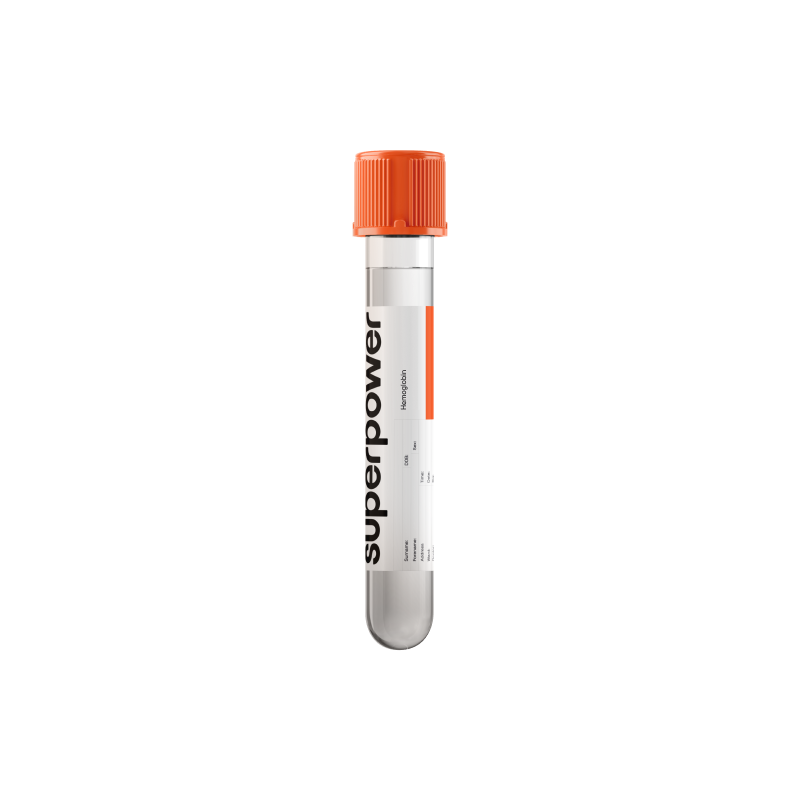Hemoglobin is the iron-rich protein inside red blood cells that binds oxygen in the lungs and delivers it to tissues throughout the body. It also carries carbon dioxide back to the lungs for exhalation. Bone marrow produces hemoglobin under the influence of erythropoietin, a hormone from the kidneys, using iron, vitamin B12, and folate as building blocks.
Key Benefits
- Check your blood’s oxygen-carrying power to screen for anemia or excess.
- Spot low hemoglobin driving fatigue, dizziness, shortness of breath, or paleness.
- Clarify unexpected high hemoglobin from dehydration, smoking, sleep apnea, or altitude exposure.
- Flag anemia that may reflect iron, B12/folate deficiency, bleeding, or kidney disease.
- Guide iron, B12, or erythropoietin therapy and monitor response to treatment.
- Protect fertility and pregnancy by screening for anemia linked to poor outcomes.
- Track trends in chronic kidney disease, heart failure, or during chemotherapy care.
- Best interpreted with MCV, ferritin, reticulocytes, and your symptoms to pinpoint cause.
What is Hemoglobin?
Hemoglobin is the red, oxygen-carrying protein inside red blood cells. It is built in the bone marrow as new red cells develop and fills most of each cell’s interior. Structurally, hemoglobin is a four-part protein (tetramer) made of two alpha and two beta chains (globins), each holding a ring-like heme group with an iron atom at its center. That iron gives hemoglobin its color and the ability to bind gases. The predominant adult form is hemoglobin A (HbA).
Its job is to pick up oxygen in the lungs and deliver it to tissues throughout the body, then carry part of the carbon dioxide back to the lungs for exhalation. Hemoglobin binds oxygen reversibly—loading where oxygen pressure is high and unloading where it is low—so it acts as the body’s main oxygen shuttle and helps set the pace of energy production (aerobic metabolism). By buffering hydrogen ions, it also helps stabilize blood acidity (pH). Because nearly all oxygen in blood rides on hemoglobin, the amount of hemoglobin reflects the blood’s capacity to transport oxygen and sustain organs and muscles, especially during exertion or illness.
Why is Hemoglobin important?
Hemoglobin is the oxygen-carrying protein inside red blood cells. It is the courier that delivers oxygen from lungs to tissues and returns carbon dioxide for exhalation, directly shaping energy production, brain clarity, muscle endurance, heart workload, and even acid–base balance. Because it also influences blood thickness, hemoglobin sits at the nexus of oxygen delivery and circulation.
Typical ranges are about 13–17 for men and 12–15 for women, with slightly lower values in pregnancy due to plasma expansion and age-dependent norms in children. The physiologic “sweet spot” is the mid-range: too low compromises oxygen delivery; too high makes blood more viscous and harder to pump. Altitude, smoking, and hormones (such as testosterone) can shift set points.
When hemoglobin is low, it reflects anemia—fewer red cells or less hemoglobin per cell—often from iron deficiency, chronic inflammation, kidney disease (reduced erythropoietin), blood loss, or hemolysis. Tissues run on less oxygen, leading to fatigue, shortness of breath, dizziness, palpitations, headaches, pallor, and cold intolerance. Women with heavy menses are commonly affected; in pregnancy, low levels raise risks for preterm birth and low birthweight; in children, they can impair growth and learning; in heart or lung disease, they can worsen symptoms.
When hemoglobin is high, the body is either compensating for hypoxia (lung disease, sleep apnea, high altitude), is dehydrated (relative increase), or producing excess red cells from a marrow disorder. Blood becomes thicker, increasing headache, flushing, high blood pressure, clot risk, and strain on the heart.
Big picture: hemoglobin integrates iron stores, kidney signaling, bone marrow health, and lung–heart performance. Sustained deviations—low or high—affect exercise capacity, cognition, pregnancy outcomes, and long-term risks such as heart failure or thrombosis.
What Insights Will I Get?
Hemoglobin is the iron-containing protein inside red blood cells that carries oxygen from the lungs to tissues and returns carbon dioxide. It directly reflects the blood’s oxygen-carrying capacity, shaping cellular energy production, exercise tolerance, cognition, thermoregulation, cardiac workload, fertility, and immune resilience.
Low values usually reflect too few red blood cells or too little hemoglobin per cell (anemia) or dilution from expanded plasma volume. Common drivers include iron lack, chronic inflammation or kidney disease (low erythropoietin), blood loss (including menstruation), pregnancy, B12/folate deficiency, hemolysis, or marrow disorders. System effects are reduced oxygen delivery: fatigue, shortness of breath, reduced exercise capacity, dizziness, palpitations, headaches, colder extremities, and impaired concentration. Low values are more frequent in children and people who menstruate; pregnancy has lower physiologic thresholds, yet very low levels raise fetal risk.
Being in range suggests adequate oxygen delivery and balanced red cell production (erythropoiesis), with sufficient iron availability, healthy marrow response, appropriate kidney hormone signaling, and stable hydration. For most, optimal sits near the middle of the sex- and altitude-specific reference range.
High values usually reflect increased red cell mass (erythrocytosis) or reduced plasma volume (hemoconcentration). Typical causes include dehydration, chronic low oxygen from lung or heart disease, sleep-disordered breathing, high altitude, smoking (carboxyhemoglobin), androgen or erythropoietin exposure, or a myeloproliferative disorder such as polycythemia vera. Effects stem from thicker blood (hyperviscosity): headaches, visual changes, flushing, circulatory strain, and higher clot risk. Newborns normally run higher.
Notes: Interpretation varies with age, sex assigned at birth, pregnancy trimester, altitude, smoking status, acute illness, hydration, and recent bleeding or transfusion. Body position and lab methods can shift results slightly. Hematocrit, RBC count/indices, reticulocytes, iron studies, kidney function, and oxygen saturation provide essential context.



.svg)



.png)
.png)
.png)
.png)








